Fritz Vahrenholt - Duped on Climate Change
Posted on 15 February 2012 by dana1981
German electric utility executive Fritz Vahrenholt is co-author (along with geologist Sebastian Lüning) of a book expressing "skepticism" regarding the human contribution to global warming, which predictably has been trumpeted by the usual climate denial enablers. Why should we particularly care what Vahrenholt thinks about climate science? That is something of a mystery - he has a PhD in chemistry and has worked in the energy sector for Shell Oil and wind turbine maker RePower. Vahrenholt and Lüning both currently work for RWE Innogy, Germany's second-largest energy company (Vahrenholt as a manager, Lüning as a scientist in its oil and gas division).
Vahrenholt admits he has no expertise in climate science, but apparently his status as "Germany’s Top Environmentalist" (a title which Vahrenholt appears to have been awarded just recently by anti-climate think tanks and denialists) and his climate "skepticism" are sufficient for some people to take his climate claims seriously.
In an interview with Der Spiegel, Vahrenholt discusses why he chose to write a book rather than attempting to conduct and publish scientific research.
SPIEGEL: You make concrete statements on how much human activity contributes to climatic events and how much of a role natural factors play. Why don't you publish your prognoses in a professional journal?
Vahrenholt: Because I don't engage in my own climate research. Besides, I don't have a supercomputer in my basement. For the most part, my co-author, geologist Sebastian Lüning, and I merely summarize what scientists have published in professional journals -- just as the IPCC does.
However, as we will soon see, the difference between Vahrenholt and the IPCC is that the latter accurately summarizes the body scientific literature, while the former misrepresents his sources and only listens to a few select "skeptic" scientists.
Misrepresenting the IPCC
In the interview, Vahrenholt makes a statement about the IPCC which reveals that he simply has not done his research.
"The long version of the IPCC report does mention natural causes of climate change, like the sun and oscillating ocean currents. But they no longer appear in the summary for politicians. They were simply edited out."
Vahrenholt refers to the IPCC Fourth Assessment Report Summary for Policymakers (SPM). The following quotes are taken directly from the SPM, which Vahrenholt claims has edited out all mention of natural causes of climate change. The first quote is the first sentence in the SPM.
* "The Working Group I contribution to the IPCC Fourth Assessment Report describes progress in understanding of the human and natural drivers of climate change, observed climate change, climate processes and attribution, and estimates of projected future climate change."
* "Human and Natural Drivers of Climate Change
Changes in the atmospheric abundance of greenhouse gases and aerosols, in solar radiation and in land surface properties alter the energy balance of the climate system. These changes are expressed in terms of radiative forcing, which is used to compare how a range of human and natural factors drive warming or cooling influences on global climate."
* "Changes in solar irradiance since 1750 are estimated to cause a radiative forcing of +0.12 [+0.06 to +0.30] W m–2, which is less than half the estimate given in the TAR."
* "It is very unlikely that climate changes of at least the seven centuries prior to 1950 were due to variability generated within the climate system alone. A significant fraction of the reconstructed Northern Hemisphere inter-decadal temperature variability over those centuries is very likely attributable to volcanic eruptions and changes in solar irradiance, and it is likely that anthropogenic forcing contributed to the early 20th century warming evident in these records."
* "The observed widespread warming of the atmosphere and ocean, together with ice mass loss, support the conclusion that it is extremely unlikely that global climate change of the past 50 years can be explained without external forcing, and very likely that it is not due to known natural causes alone."
There are more such examples. Then there's Figures SPM.2 and SPM.4:
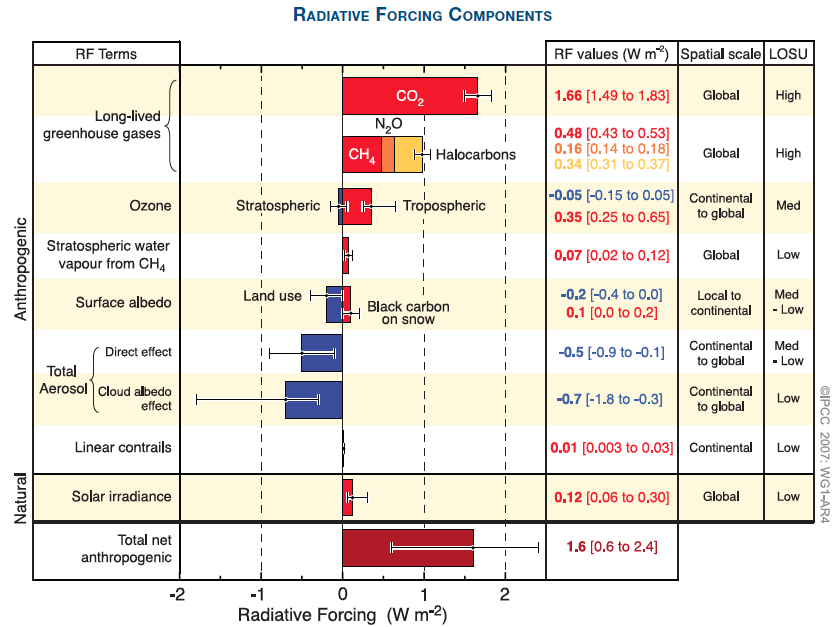
Figure SPM.2: Global average radiative forcing (RF) estimates and ranges in 2005 for anthropogenic carbon dioxide (CO2), methane (CH4), nitrous oxide (N2O) and other important agents and mechanisms, together with the typical geographical extent (spatial scale) of the forcing and the assessed level of scientific understanding (LOSU). The net anthropogenic radiative forcing and its range are also shown. These require summing asymmetric uncertainty estimates from the component terms, and cannot be obtained by simple addition. Additional forcing factors not included here are considered to have a very low LOSU. Volcanic aerosols contribute an additional natural forcing but are not included in this figure due to their episodic nature. The range for linear contrails does not include other possible effects of aviation on cloudiness.
Figure SPM.4 - Comparison of observed continental- and global-scale changes in surface temperature with results simulated by climate models using natural and anthropogenic forcings. Decadal averages of observations are shown for the period 1906 to 2005 (black line) plotted against the centre of the decade and relative to the corresponding average for 1901–1950. Lines are dashed where spatial coverage is less than 50%. Blue shaded bands show the 5–95% range for 19 simulations from five climate models using only the natural forcings due to solar activity and volcanoes. Red shaded bands show the 5–95% range for 58 simulations from 14 climate models using both natural and anthropogenic forcings.
Clearly the SPM explicitly discusses natural contributions to global warming, and explains that according to the body of scientific evidence, their contribution to the observed warming is small. Frankly if Vahrenholt can't even accurately read the 18-page SPM, it's exceptionally difficult to take him seriously. His subsequent comments in the interview reveal that he has been very selective about what scientific research he chooses to accept.
Misrepresenting Global Warming
Early in the interview, Vahrenholt repeats a myth which has become increasingly popular amongst climate contrarians.
"It hasn't gotten any warmer on this planet in almost 14 years, despite continued increases in CO2 emissions. Established climate science has to come up with an answer to that."
Of course our first answer must point out that Vahrenholt's assertion is false. Over the past 14 years, the average global surface temperature has warmed approximately 0.13°C, according to data from the NASA Goddard Institute for Space Studies. And of course surface air warming only represents a very small percentage of global warming, which has continued uninterrupted:
Figure 1: Global heat content, data from Church et al 2011.
And of course there's the fact that the odd timeframe choice of 14 years conveniently begins at the peak of the strongest El Niño in a century (a.k.a. cherrypicking of short-term data). This cherrypicking is illustrated by The Escalator, which was used by German newspaper Die Zeit to debunk this myth from Vahrenholt's book (Figure 2).
Figure 2: Die Zeit use of The Escalator
We should note that while we are flattered that Die Zeit has described Skeptical Science as "an internet platform close to the IPCC" in their figure caption, we are in no way affiliated with the IPCC.
The second answer to Vahrenholt's concern about the dampened surface warming over the past decade or so involves the fact that virtually every non-greenhouse gas effect acted in the cooling direction over that period. Human aerosol emissions increased, blocking more sunlight. Heat accumulated in the deep oceans. The solar cycle went into an extended minimum. There were a number of strong La Niña events. Foster and Rahmstorf (2011) showed that when we filter out the latter two effects and that of volcanic activity, the warming of surface temperatures has not even slowed (Figure 2).
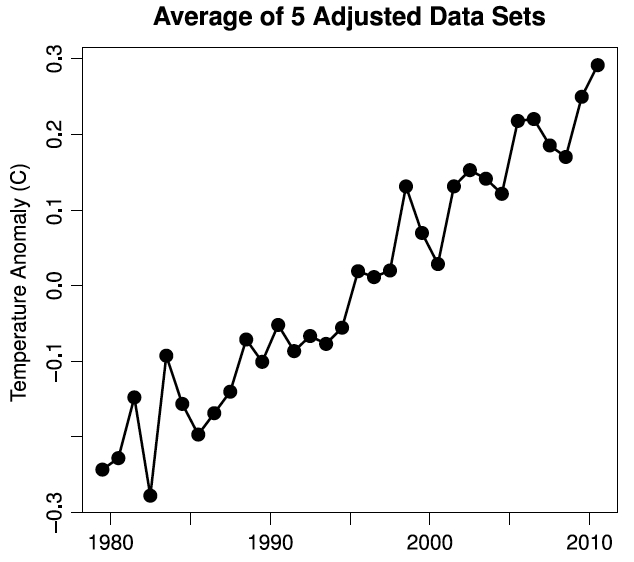 Figure 2: Average temperature changes recorded by 5 teams of scientists: 2 working on satellites (University of Alabama, Huntsville and Remote Sensing Systems) and 3 working with thermometers and ship/buoy measurements (UK Hadley Centre & Climate Research Unit, NASA Goddard Institute for Space Studies and the US National Climatic Data Centre. Foster and Rahmstorf (2011) statistical methods have been used to 'take out' the effects of volcanic eruptions, Pacific Ocean cycles and the Sun.
Figure 2: Average temperature changes recorded by 5 teams of scientists: 2 working on satellites (University of Alabama, Huntsville and Remote Sensing Systems) and 3 working with thermometers and ship/buoy measurements (UK Hadley Centre & Climate Research Unit, NASA Goddard Institute for Space Studies and the US National Climatic Data Centre. Foster and Rahmstorf (2011) statistical methods have been used to 'take out' the effects of volcanic eruptions, Pacific Ocean cycles and the Sun.
Blaming the Sun
Like David Archibald, Vahrenholt exaggerates the solar influence on global temperature.
"In the second half of the 20th century, the sun was more active than it had been in more than 2,000 years. This "large solar maximum," as astronomers call it, has contributed at least as much to global warming as the greenhouse gas CO2."
In the second half of the 20th century, solar activity was also flat. Vahrenholt does not seem to understand that the climate responds to increasing solar activity, not flat solar activity, even if at a relatively high level. It's true that solar activity increased leading up to the mid-20th century, which contributed to the warming observed from about 1910 to 1940. However, total solar irradiance (TSI) increased by less than 2 Watts per square meter (W/m2) leading up to 1940 (i.e. see Vieira 2011 and Jones 2012, with more recent reconstructions showing a smaller TSI increase of generally less than 1 W/m2 during this period).
We can estimate the equilibrium temperature response to this TSI increase by multiplying the radiative forcing by the climate sensitivity parameter (λ).
The solar radiative forcing for a 2 W/m2 increase in TSI is just 0.35 W/m2, compared to the ~1.6 W/m2 radiative forcing from increased CO2. These radiative forcings will cause an equilibrium surface warming of approximately 0.3°C and 1.3°C, respectively. So no, the increase in solar activity has not contributed nearly as much to global warming as the CO2 increase.
Blaming Ocean Cycles and Galactic Cosmic Rays
When confronted with the flat TSI trend over the past ~60 years by the Der Spiegel interviewer (who did a nice job challenging Vahrenholt's many myths throughout the interview), Vahrenholt invoked ocean cycles and galactic cosmic rays (GCRs) to explain the observed global warming.
"There are two effects: the declining solar activity, as well as the fluctuations in ocean currents, such as the 60-year Pacific oscillation, which was in a positive warm phase from 1977 to 2000 and, since 2000, has led to cooling as a result of its decline. Their contribution to the change in temperature has also been wrongly attributed to CO2. Most of all, however, the last sunspot cycle was weaker than the one before it. This is why the sun's magnetic field has continued to weaken since 2000. As a result, this magnetic field doesn't shield us against cosmic radiation quite as well, which in turn leads to stronger cloud formation and, therefore, cooling. What else has to happen before the IPCC at least mentions these relationships in its reports?"
Once again Vahrenholt has misrepresented the IPCC report, which does discuss GCRs (i.e. here and here) and the Pacific Decadal Oscillation (i.e. here and here). The IPCC report correctly notes that the body of scientific research has shown that GCRs have little if any effect on cloud cover and thus global temperature, and even if they did, like TSI, solar magnetic field strength has remained steady over the past ~60 years (as has GCR flux on Earth). Oceanic oscillations are just that - oscillations switching between positive and negative states, moving heat around between the oceans and atmosphere. Since both oceans and atmosphere are warming, it must be due to an external forcing, not an internal oscillation.
Vahrenholt Misrepresents Kirkby and CERN
The following exchange between Vahrenholt and the Der Spiegel interviewer is very representative of the interview as a whole.
Vahrenholt: It's more than that. The Cloud Experiment, headed by physicist Jasper Kirkby, has been underway at the CERN particle research center near Geneva since 2006. The initial results of tests conducted in a chamber in which the earth's atmosphere was simulated showed that cosmic particles do indeed lead to the formation of aerosol particles for clouds.
SPIEGEL: But the aerosols demonstrated in the Cloud Experiment are much too small. They would have to grow before they could actually serve as condensation germs for clouds. Whether this happens in nature is still an open question. You present this as a fact.
Vahrenholt: You will find many correlations between cloud cover and cosmic radiation in the book. I'd like to know why the IPCC doesn't thoroughly examine this mechanism. My guess is that the answer to this question would jeopardize the entire foundation of the IPCC predictions.
Vahrenholt misrepresents the scientific evidence, in this case Kirkby and CERN's results, which Kirkby himself states "says nothing about a possible cosmic-ray effect on clouds and climate, but it’s a very important first step." The interviewer catches Vahrenholt in this misrepresentation, and Vahrenholt responds by claiming some research exists which supports his myth, and that the IPCC is ignoring it. In reality, the IPCC has discussed the issue in great detail, as demonstrated above.
Vahrenholt is Indeed Duped
In short, we end the way we began, wondering why anybody takes Vahrenholt's comments on the climate seriously. Not only does he lack expertise in the subject, but he clearly has not done his research, and misrepresents most of the sources he references. Toward the end of the interview, Vahrenholt provides a comment which Der Spiegel used in the title of the article:
"...I feel duped."
Indeed Vahrenholt has been duped, by his own shoddy research, and has also duped many of his readers in the process.
Note: Vahrenholt and Lüning have published a response to some of the criticism of their work. However, their response doesn't really contain any new information, and doesn't seriously address any of the criticms leveled in this post (in addition to completely missing the point of The Escalator, as other "skeptics" have).































 Arguments
Arguments





















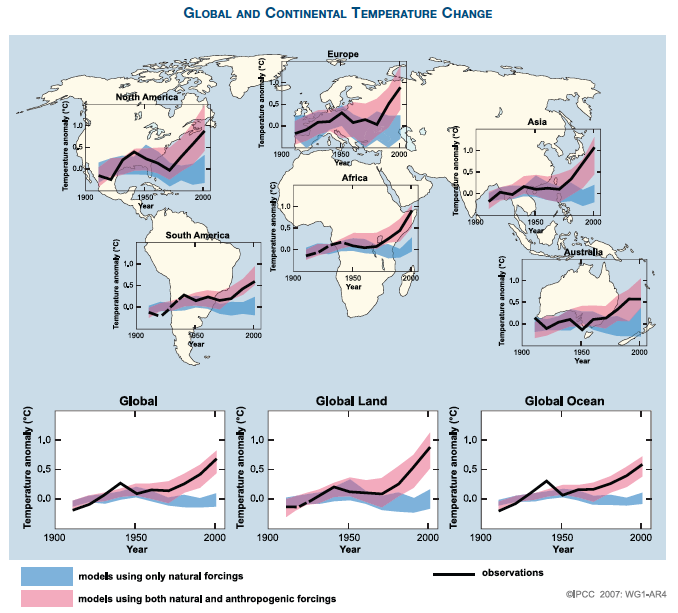
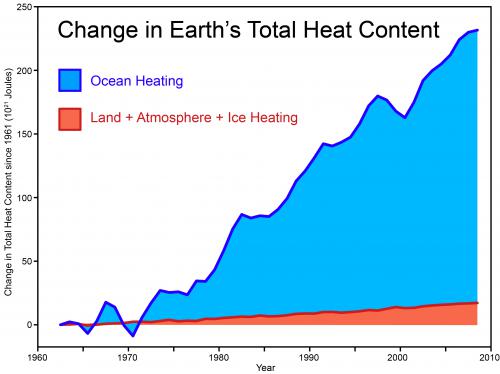
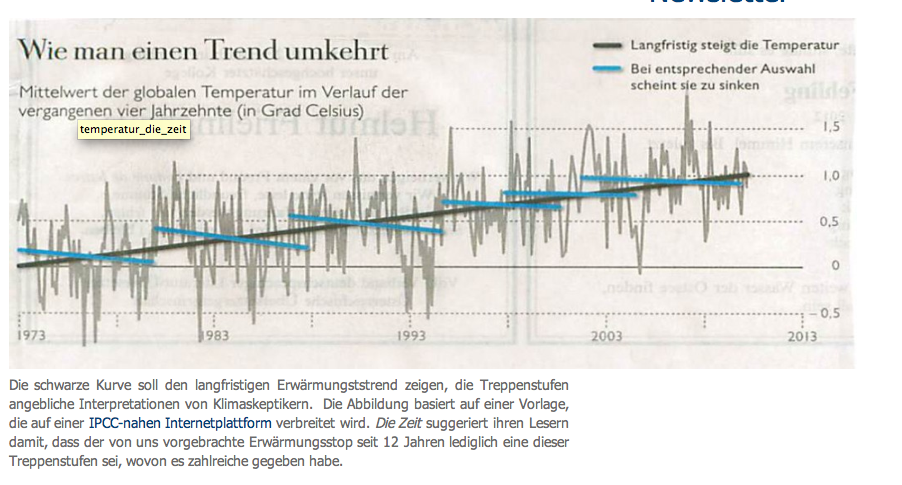


 0
0  0
0 And they even have the nerve to call climate science weak!
And they even have the nerve to call climate science weak!







Comments